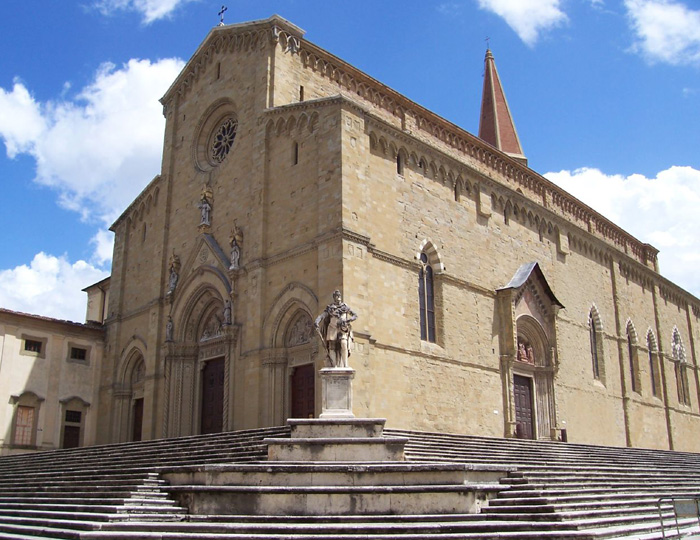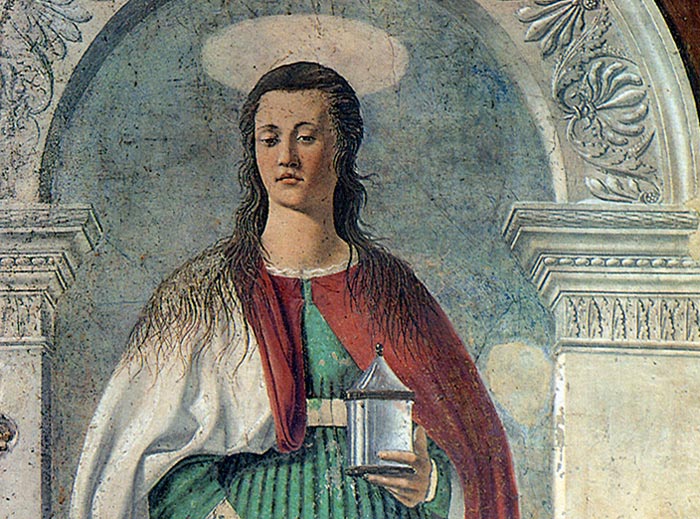| |
|
Arezzo Cathedral (Italian: Cattedrale di Arezzo, Duomo di Arezzo, Cattedrale di Ss. Donato e Pietro) is located on the site of a pre-existing Palaeo-Christian church and, perhaps, of the ancient city's acropolis.
The late XIII century Gothic church, decorated with splendid stained glass windows by Guillaume de Marcillat (XVI cent.), houses the beautiful fresco of Santa Maria Maddalena by Piero della Francesca (1460).
History
A first cathedral of Arezzo was built on the nearby Pionta Hill, over the burial place of Donatus of Arezzo, martyred in 363. In 1203 Pope Innocent III had the cathedral moved within the city's walls, in the current site. The Cathedral, however, lost the relics of Donatus, which were transferred in the church of San Donato in Castiglione Messer Raimondo (in what is now the province of Teramo). In spite of this, the church is still entitled to St. Donatus and houses, at the high altar, a 14th-century arch named after him.
The construction of the current structure, started in 1278, went through different phases, and ended in 1511. The façade was built in 1901-1914, replacing the previous, unfinished one, dating to the 15th century.
It was the seat of the Bishop of Arezzo from the 3rd century until 1986, and from 1986 onwards of the present Bishop of Arezzo-Cortona-Sansepolcro.[1]
Description
Exterior
|
|
|
|
| |
|
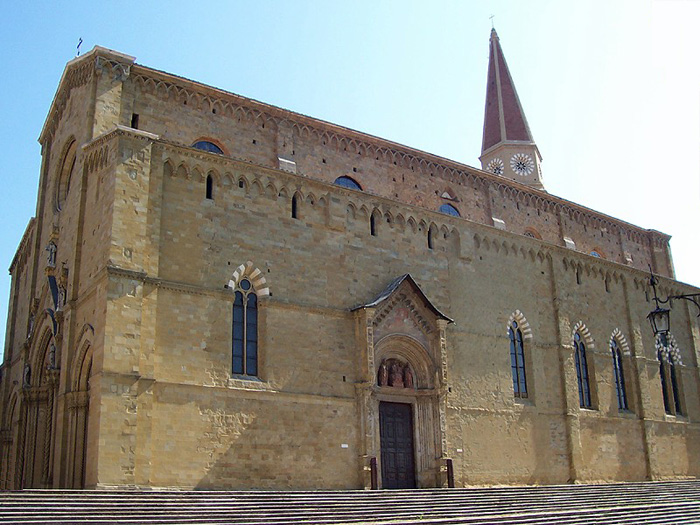 |
Duomo, Cattedrale dei Santi Pietro e Donato ad Arezzo
|
The façade was designed by Dante Viviani and has a sculpture description by Giuseppe Cassioli, Enrico Quattrini and Viviani himself.
The right side of the church is from the original medieval building, in sandstone. In the middle is a 14th-century portal in Florentine style, with two porphyry columns taken from an ancient temple. The polygonal apse, with double mullioned windows, dates to the 13th century.
Interior
The interior has a nave and two aisles divided by piers with ogival arches, with five spans covered by cross vault, without a transept. The seven stained glass windows in the right aisles were executed in 1516-1524 by Guillaume de Marcillat. Other stained glass windows are in the presbytery, one also by Marcillat and another by early 15th century Florentine masters.
The presbytery houses a large arch dedicated to St. Donatus. Sculpted in marble, it has twelve small piers ending with spires and pinnacles in Gothic style and was executed by Florentine, Aretine and Sienese artists of the 14th century, including (in the lower section) Agnolo di Ventura and Agostino di Giovanni. The wooden choir of the Grand Chapel was designed by Giorgio Vasari in 1554.
I n the counter-façade is the hexagonal baptismal font, with reliefs by Donatello's workshop, including a Baptism of Christ by Donatello himself. The Chapel of Madonna del Confort is a Neoclassicist work, built from 1796 and housing several terracottas by Andrea della Robbia. In the same side is the cenotaph of Guido Tarlati, lord of Arezzo until 1327. According to some, it was designed by Giotto, and executed by Agnolo di Ventura and Agostino di Giovanni. Near to the cenotaph is Piero della Francesca's Mary Magdalene (1460s).
In the right aisle is the funerary monument of Pope Gregory X (died 1276), dating to the early 14th century. Another funerary monument in the aisles is that of Ciuto Tarlati (1334), formed by a marble sarcophagus of the 4th century AD and a series of reliefs by Agostino di Giovanni, crowned by a 14th-century fresco.
Parrocchia Dei Santi Donato E Pietro In Cattedrale
Indirizzo: 1 Piazza Del Duomo, Arezzo, AR 52100
Piero della Francesca, Maria Maddalena
More or less at the same time as he was working on the final scenes of the San Francesco cycle, Piero was given another important commission in Arezzo: the fresco of Mary Magdalen in the Cathedral. This monumental figure is created entirely by large patches of bright colours, rather like an early 16th-century Venetian painting. Yet even with this new use of colour Piero still concentrates on the attention to detail typical of his mature works: the shining light reflections on the small bottle, the hair that is depicted strand by strand on the saint's solid shoulders.
|
|
Piero della Francesca, Santa Maria Maddalena (detail), fresco, 190 cm × 105 cm, Cattedrale di San Donato, Arezzo
|
| 'The resetting on the same wall as the fresco of the tomb of Bishop Guido Tarlati, in 1783, has trimmed it on the left. Below, a part of the lintel is missing.
The saint is represented beyond an arch, which rises from a base just under two metres from the ground. Behind her, a marble parapet separates her from the sky, painted in azurite. The halo, seen in perspective, was gilded, as were probably the belt and the sleeve of the dress. The perspective of the architecture consists simply in the convergence of lines towards a single point above the head of the spectator. The arch, in white stone against a dard red background (a dichromatism which Piero already employed in the Flagellation) appears very thin; its principal lines defined by incisions in the fresh plaster. It was painted on different days from those of the sky and the saint. A confusion can be seen at the left base, which seems covered by a drape of the saint's green dress. A hinted counterpoint regulates the relationship between the Magdalen and the architecture that surrounds her, unfolding boldly like a two-dimensional frame, while the saint's shoulders are on slightly different levels, giving a clue to a movement that cancels the possible implication of a statuary image placed in a niche. The saint is well behind the frame, illuminated by the same light that gives life to the reliefs in the architecture. She is in a free, solar space, where the weather is vibrant through the luminosity of the sky. The strong colour brings her back to the surface at the same time as the bold relief shapes her. Inserted between the two complimentary dominants, red and green, the grey satin of the hem of the woollen mantle reflects more light that the white of the edge of
the right arch. The spectacular display of the hair on her shoulders is set against the broad coloured surfaces. The solar light becomes subaqueus and almost lunar in the oil jar, that becomes a source of further light, in contact with the saint's left hand. Her blooming beauty, the young curving neck, the delicate indentations round the lips make her the ideal companion of the young St Julian at Sansepolcro, but without his troubled expression, in a serenity that would not appear again until the paintings of Cima da Conegliano. In fact the generous colour, which almost presses against the surface through its energy, marks the meeting with Antonello da Messina in Rome. This remarkable essay, painted close to horne, must be dated just after the Roman period.
Usually given a date near the San Francesco frescoes, it has been ascribed to 1452, or c. 1466 and beyond.'[2]
|
|
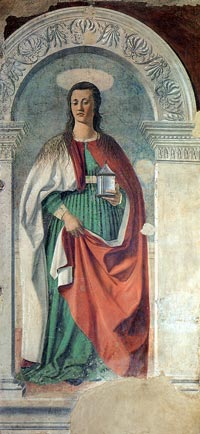
Piero della Francesca, Santa Maria Maddalena (detail), fresco, 190 cm × 105 cm, Cattedrale di San Donato, Arezzo
|
|
Monuments in Arezzo
|
|
|
Arezzo lies on a hill close to the Appennino Tosco-Romagnolo. As its architecture proves, Arezzo boasts its ancient origin first as one of the greatest Etruscan towns and then a strategic Roman city. The upper part keeps a remarkable medieval aspect with the Cathedral and the Medici Fortress. The rather Gothic Cathedral contains fine works of art among which La Maddalena by Piero della Francesca and the stained-glass windows by Guillame de Marcillat. The central Piazza Grande shows different styles of architecture: next to the medieval towers are the imposing Renaissance Loggiato Vasariano, the Palazzo delle Fraternita dei Laici, a mixture of Gothic and Renaissance architecture, and the apse of the Pieve di Santa Maria. The Piazza Grande hosts annually the Giostra del Saracino, a tournament held on the third Sunday of June and the first Sunday of September, and the Antique Fair on the first weekend of every month. The Bacci Chapel in the Basilica di San Francesco houses the stunning Renaissance cycle of frescoes of The legend of the True Cross by Piero della Francesca. The single-nave church of San Domenico houses the newly restored Crucifix by Cimabue. Many other churches and palaces prove how important and original in the centuries Arezzo was. Notable are the Badia delle Sante Flora e Lucilla, the church of La Santissima Annunziata, Palazzo Pretorio and Palazzo dei Priori, and at a few minutes outside the walls, the church of Santa Maria delle Grazie, the Romanesque Pieve di Sant'Eugenia al Bagnoro. The museums offer a large variety of remarkable works of art: the Museo Archeologico Gaio Cilnio Mecenate, the Museo Statale d'Arte Medievale e Moderna, the Museo and Casa Vasari, the Casa Museo Ivan Bruschi and the Museo Diocesano.
[I Monumenti della Provincia di Arezzo | www.turismo.provincia.arezzo.it]
|
|
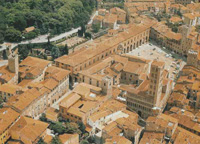
|
La Basilica di San Francesco
|
The Basilica of San Francesco is a late Medieval church in Arezzo, Tuscany, Italy, dedicated to St Francis of Assisi. It is especially renowned for housing in the chancel the fresco cycle Legends of the True Cross by Piero della Francesca.
San Francesco is the second church built by the Franciscans in Arezzo, an earlier church being located outside the city walls and destroyed during the Occupation. The building work on San Francesco was begun around 1290. The decoration of its façade was never realised.
The interior presents as a large church of simple unadorned design with a wide single nave, flanked on the left side by some chapels and, on the right side, by some niches. The tall groin-vaulted chancel is of square plan.
Beneath the church is a smaller Chiesa inferiore or "Lower Church" as at Assisi, with a nave and two aisles, now used as exhibition hall.
At the chancel entrance is suspended a very large painted rood crucifix by one Master of San Francesco, a contemporary of Cimabue. It also contains a Maesta or "Madonna in Majesty" by Guido da Siena.
The walls and particularly the niches on the right have some fresco decoration, which dates in part to the 14th century.
The Cappella Maggiore, (Major Chapel or chancel) houses one of the masterworks of Italian Early Renaissance, a fresco cycle by Piero della Francesca depicting the Legend of the True Cross.
The painting of the chancel began with a commission by the Aretine family Bicci, who called the painter Bicci di Lorenzo to paint the large cross-vault. In 1452, at Bicci's death, only the four Evangelists had been painted in the vault, as well as the triumphal arch with the Last Judgement and two Doctors of the Church.
Piero della Francesca was called in to complete the work. According to a document, he did so in two stages, the works halted during 1458-1459, and completed in 1466.
The frescoes occupy three levels on the side walls and the eastern wall, surrounding a large window. The theme of the fresco cycle is the from the Golden Legend by Jacopo da Varagine. Piero della Francesca did not follow a chronological order, preferring to concentrate himself in the creation of symmetrical correspondences between the various scenes.
Il Crocifisso di San Domenico ad Arezzo
|
|
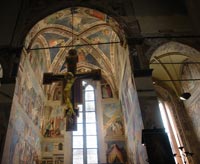 La Cappella Maggiore di San Francesco, Arezzo La Cappella Maggiore di San Francesco, Arezzo
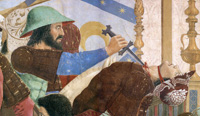
|
La chiesa di San Domenico, the Church of Saint Domenic, with its eye-catching asymmetrical double bell gable, is named after the 13th century founder of the Dominicans or the Order of the Preachers.
The bells, which still hang and regularly ring from the belfry, are from the 14th century when construction on the church, which began in 1275, was finally completed.
Inside, you’ll find a single nave and walls decorated with 14th and 15th century frescoes by Aretine and Sienese artists including The Crucifixion by 15th century Aretine painter Parri di Spinello.
Of most interest, however, is the large painted crucifix. This is one of 13th century master painter Cimabue’s famous wooden crucifixes, painted in 1265 in a then-breakaway style showing pathos and emotion of the suffering Christ.
The small church forms the focal piece of the Piazza San Domenico or Saint Domenic’s Square that spreads out before it and is a place of quiet meditation. |
|
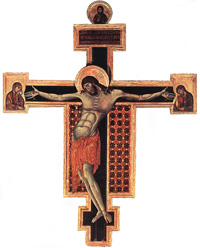
Cimabue, Crucifix, 1268-71, tempera on wood, 336 x 267 cm, San Domenico, Arezzo |
|
|
|
|
|
| |
|

[1] Source: I Comuni della Provincia di Arezzo | www.turismo.provincia.arezzo.it
[2] Carlo Bertelli, Piero della Francesca, Silvana, 1991, p.194
[3] Guillaume de Marcillat (ca. 1470-1529) was a French painter and stained glass artist.
He was born in La Châtre, Indre about 1470. He was in Rome by 1509, where he was employed by the popes Julius II and Leo X in the Vatican and at Santa Maria del Popolo, where the two windows in the choir are his earliest surviving works. In 1515, he was summoned by Cardinal Silvio Passerini to Cortona, where he established a workshop, that produced stained glass windows for the Madonna del Calcinaio Cathedral. By 1519 he was in Arezzo, where he produced windows for the Cathedral of Arezzo and the The Basilica of San Francesco. He also painted biblical frescos in the vault of the Cathedral of Arezzo. He died in Arezzo in 1529.
Bibliography
Birgit Laskowski, Piero della Francesca, collana Maestri dell'arte italiana, Gribaudo, Milano 2007. ISBN 978-3-8331-3757-0
Pietro Allegretti, Piero della Francesca, collana I classici dell'arte, Rizzoli/Skira, Milano 2003, pp. 1132-1133.
Henry, Tom, "Centro e Periferia": Guillaume de Marcillat and the Modernisation of Taste in the Cathedral of Arezzo", Artibus et Historiae, Vol. 15, No. 29 (1994), 55-83.
Vasari, Giorgio, Le Vite delle più eccellenti pittori, scultori, ed architettori, many editions and translations.
|

Art in Tuscany | The Crucifix in San Domenico in Arezzo
Giorgio Vasari | Le vite de' più eccellenti architetti, pittori, et scultori italiani, da Cimabue insino a' tempi nostri | Cimabue | Piero della Francesca
Art in Tuscany
| Cimabue | Piero della Francesca
|
This article incorporates material from the Wikipedia articles Arezzo Cathedral, San Francesco, Arezzo, Guillaume de Marcillat and Maria Maddalena (Piero della Francesca) published under the GNU Free Documentation License.
Wikimedia Commons has media related to: Cathedral (Arezzo).
Sources
(2003). Toscana. Guida d'Italia. Milan: Touring Club Italiano.
|

Tuscany is one of the most popular tourist destinations in the world. Known for its enchanting landscapes, its fantastic and genuine food and beautiful towns as Florence, Pisa, Lucca and Siena. Podere Santa Pia is an elegant and luminous house and attached apartment in the characteristic Maremma region.
Podere Santa Pia, a former cloister with an authentic character, is located in the heart of the Valle d'Ombrone, and one can easily reach some of the most beautiful attractions of Tuscany, such as Montalcino, Pienza, Montepulciano and San Quirico d'Orcia, famous for their artistic heritage, wine, olive oil production and gastronomic traditions.
Tuscan holiday houses | Podere Santa Pia
|
| |
|
|
 |
Podere Santa Pia. The hills are clothed in Mediterranean bush
and mixed woodland, teaming with rare flowers,
butterflies and game;
wonderful for long exploratory walks.
|
| |
|
|
![]()
![]()
![]()
![]()
![]()

